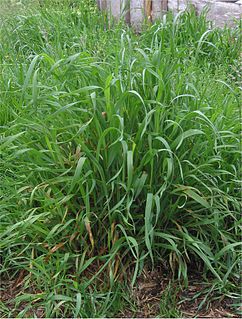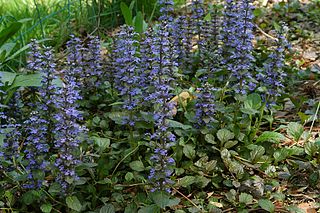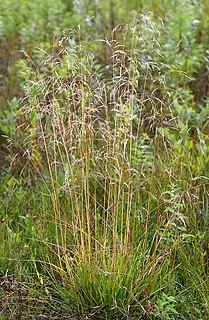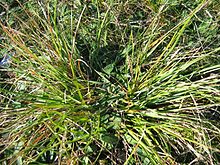
Elymus repens, commonly known as couch grass, is a very common perennial species of grass native to most of Europe, Asia, the Arctic biome, and northwest Africa. It has been brought into other mild northern climates for forage or erosion control, but is often considered a weed.

Molinia caerulea, known by the common name purple moor-grass, is a species of grass that is native to Europe, west Asia, and north Africa. It grows in locations from the lowlands up to 2,300 m (7,546 ft) in the Alps. Like most grasses, it grows best in acid soils, ideally pH values of between 3.5 and 5, however, it can continue to live under more extreme conditions, sometimes to as low as 2. It is common on moist heathland, bogs and moorland throughout Britain and Ireland. Introduced populations exist in northeastern and northwestern North America.

Brachypodium sylvaticum, commonly known as false-brome, slender false brome or wood false brome, is a perennial grass native to Europe, Asia and Africa. It has a broad native range stretching from North Africa to Eurasia.

Ajuga reptans is commonly known as bugle, blue bugle, bugleherb, bugleweed, carpetweed, carpet bugleweed, and common bugle, and traditionally but less commonly as St. Lawrence plant. It is an herbaceous flowering plant, in the mint family, native to Europe. It is invasive in parts of North America. Ajuga reptans is also a component of purple moor grass and rush pastures, a Biodiversity Action Plan habitat in the United Kingdom.

Deschampsia cespitosa, commonly known as tufted hairgrass or tussock grass, is a perennial tufted plant in the grass family Poaceae. Distribution of this species is widespread including the eastern and western coasts of North America, parts of South America, Eurasia and Australia.

Tragopogon pratensis is a biennial plant in the family Asteraceae, distributed across Europe and North America, commonly growing in fields and on roadsides. It is found in North America from southern Ontario to Massachusetts; most of England; on the eastern and southern edges of Scotland; and central Ireland but not the coastal edges.

Briarcroft Pasture is a 1.76 hectare biological Site of Special Scientific Interest in County Durham, England notified in 2004.

Lambert's Castle is an Iron Age hillfort in the county of Dorset in southwest England. Since 1981 it has been designated as a Site of Special Scientific Interest (SSSI) on account of its geology, archaeology and ecology. The hillfort is designated a scheduled monument together with a bowl barrow, the sites of a post-medieval fair and a telegraph station.

Stellaria graminea is a species of flowering plant in the family Caryophyllaceae known by the common names common starwort, grass-leaved stitchwort, lesser stitchwort and grass-like starwort.

Danthonia is a genus of Eurasian, North African, and American plants in the grass family. Members of this genus are sometimes referred to as oatgrass, but that common name is not restricted to this genus. Other common names include heathgrass and wallaby grass. Australian species have since been reclassified into the genus Rytidosperma.

Danthonia californica is a species of grass known by the common name California oatgrass. This plant is native to two separate regions of the Americas, western North America from California to Saskatchewan, and Chile.

Festuca idahoensis is a species of grass known by the common names Idaho fescue and blue bunchgrass. It is native to western North America, where it is widespread and common. It can be found in many ecosystems, from shady forests to open plains grasslands.

Bromus madritensis is a species of brome grass known by the common name compact brome. The specific epithet madritensis refers to Madrid, Spain. It has a diploid number of 28.

Aira praecox is a species of grass known by several common names, including early hair-grass, yellow hairgrass and spike hairgrass. It is native to Europe, where it is found in dry, sandy places, on rocky outcrops, and in heath grassland. It also grows in North America as an introduced species, where it can be found on the east and west coasts in sandy or rocky areas, such as beaches and roadsides. This is a tuft-forming annual grass growing up to about 25 centimeters in maximum height. The thin, narrow leaves are located at the base of the stem, and are typically 0.3–2 millimeters wide. It bears very small inflorescences of purple-tinted green bisexual spikelets.

Nardus is a genus of plants belonging to the grass family, containing the single species Nardus stricta, known as matgrass. It is placed in its own tribe Nardeae within the subfamily Pooideae. The name derives from ancient Greek nardos from the earlier Akkadian lardu. It is not to be confused with spikenard, Nardostachys jatamansi.

Ranunculus recurvatus, the blisterwort or hooked crowfoot, is a plant species of the genus Ranunculus in the family Ranunculaceae native to eastern North America. It is an early-flowering plant of moist deciduous woods from central Quebec south to Florida.
Sagina decumbens is a species of flowering plant in the family Caryophyllaceae known by the common names trailing pearlwort and western pearlwort. It is native to several areas of North America, where it can be found in many types of habitat. It is a small annual herb producing a threadlike green or purplish stem growing erect or trailing, measuring up to about 16 centimeters long. The leaves are hairless, linear in shape, and one half to two centimeters long. The inflorescence is a solitary flower borne on a threadlike pedicel. The flower has usually five sepals and five tiny white petals. There are two subspecies which differ mainly in the microscopic appearance of the seeds.

Silene gallica is a species of flowering plant in the family Caryophyllaceae known by several common names, including common catchfly, small-flowered catchfly, and windmill pink. It is native to Eurasia and North Africa, but it can be found throughout much of the temperate world as a common roadside weed.

Ceanothus herbaceus, also known as Jersey tea, is a species of shrub in the family Rhamnaceae and is similar to Ceanothus americanus and Ceanothus sanguineus. It is a perennial shrub which is native to North America.

Bossiaea decumbens is a spreading, prostrate shrub in the pea family (Fabaceae), and is endemic to Victoria. It has alternate, variable shaped leaves and yellow pea flowers with red splotches from spring to late summer.




















